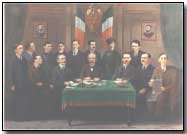 William Butler Yeats - a 1911 photograph by George Charles Beresford
William Butler Yeats - a 1911 photograph by George Charles BeresfordWilliam Butler Yeats (13 June 1865 – 28 January 1939) was an Irish poet and dramatist, and one of the foremost figures of 20th century literature. A pillar of both the Irish and British literary establishments, in his later years Yeats served as an Irish Senator for two terms. He was a driving force behind the Irish Literary Revival, and along with Lady Gregory and Edward Martyn founded the Abbey Theatre, serving as its chief during its early years.
In 1923, he was awarded the Nobel Prize in Literature for what the Nobel Committee described as "inspired poetry, which in a highly artistic form gives expression to the spirit of a whole nation." He was the first Irishman so honored. Yeats is generally considered one of the few writers who completed their greatest works after being awarded the Nobel Prize; such works include The Tower (1928) and The Winding Stair and Other Poems (1929).
Yeats was born and educated in Dublin but spent his childhood in County Sligo. He studied poetry in his youth, and from an early age was fascinated by both Irish legends and the occult. Those topics feature in the first phase of his work, which lasted roughly until the turn of the century. His earliest volume of verse was published in 1889, and those slow paced and lyrical poems display debts to Edmund Spenser and Percy Bysshe Shelley, as well as to the Pre-Raphaelite poets.
From 1900, Yeats' poetry grew more physical and realistic. He largely renounced the transcendental beliefs of his youth, though he remained preoccupied with physical and spiritual masks, as well as with cyclical theories of life. Over the years, Yeats adopted many different ideological positions, including, in the words of the critic Michael Valdez Moses, "those of [the] radical nationalist, classical liberal, reactionary conservative and millenarian nihilist".
In 1889, Yeats met Maud Gonne, then a 23-year-old heiress and ardent Nationalist. Gonne was eighteen months younger than Yeats and later claimed she met the poet as a "paint-stained art student." Gonne had admired "The Isle of Statues" and sought out his acquaintance. Yeats developed an obsessive infatuation with her beauty and outspoken manner, and she was to have a significant and lasting effect on his poetry and his life thereafter.
In later years he admitted "it seems to me that she [Gonne] brought into my life those days—for as yet I saw only what lay upon the surface—the middle of the tint, a sound as of a Burmese gong, an over-powering tumult that had yet many pleasant secondary notes." Yeats' love remained unrequited, in part due to his reluctance to participate in her nationalist activism. His only other love affair during this period was with Olivia Shakespear, whom he had first met in 1896, and parted with one year later. In 1891, he visited Gonne in Ireland and proposed marriage, but was rejected. He later admitted that from that point "the troubling of my life began". Yeats proposed to Gonne three more times: in 1899, 1900 and 1901. She refused each proposal, and in 1903, to his horror, married the Irish nationalist Major John MacBride.
Yeats' friendship with Gonne persisted, and, in Paris, in 1908, they finally consummated their relationship. "The long years of fidelity rewarded at last" was how another of his lovers described the event. Yeats was less sentimental and later remarked that "the tragedy of sexual intercourse is the perpetual virginity of the soul." The relationship did not develop into a new phase after their night together, and soon afterwards Gonne wrote to the poet indicating that despite the physical consummation, they could not continue as they had been: "I have prayed so hard to have all earthly desire taken from my love for you & dearest, loving you as I do, I have prayed & I am praying still that the bodily desire for me may be taken from you too." By January 1909, Gonne was sending Yeats letters praising the advantage given to artists who abstain from sex. Nearly twenty years later, Yeats recalled the night with Gonne in his poem "A Man Young and Old":
My arms are like the twisted thorn
And yet there beauty lay;
The first of all the tribe lay there
And did such pleasure take;
She who had brought great Hector down
And put all Troy to wreck.
In 1896, Yeats was introduced to Lady Gregory by their mutual friend Edward Martyn. Gregory encouraged Yeats' nationalism, and convinced him to continue focusing on writing drama. Although he was influenced by French Symbolism, Yeats concentrated on an identifiably Irish content and this inclination was reinforced by his involvement with a new generation of younger and emerging Irish authors.
Together with Lady Gregory, Martyn, and other writers including J. M. Synge, Sean O'Casey, and Padraic Colum, Yeats was one of those responsible for the establishment of the "Irish Literary Revival" movement. Apart from these creative writers, much of the impetus for the Revival came from the work of scholarly translators who were aiding in the discovery of both the ancient sagas and Ossianic poetry and the more recent folk song tradition in Irish. One of the most significant of these was Douglas Hyde, later the first President of Ireland, whose Love Songs of Connacht was widely admired.

No comments:
Post a Comment